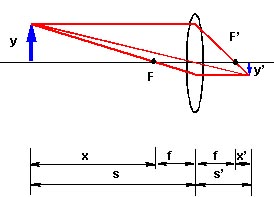


1. Mark the Focal Points (F and F`) of the lens, for a Thin Lens it
is the same distance (focal length) from either side of the Vertex (the
center of the Lens).
2. Start from the top of the Blue Arrow Object, and draw a Parallel
Line (parallel to the Optical Axis Line) to the Lens, now turn the
line to pass through the Focal Point, F' and continue on a little
ways.
3. Start again from the top of the Blue Arrow Object, this time
go through the center of the Lens where it crosses the Optical Axis, and
go through to connect to the first line.
4. Lastly, start at the Blue Arrow Object, go through the other
Focal Point till you get to the lens. Now turn and go parallel till
you intersect the other two lines. This is where the Blue Arrow Image
forms.